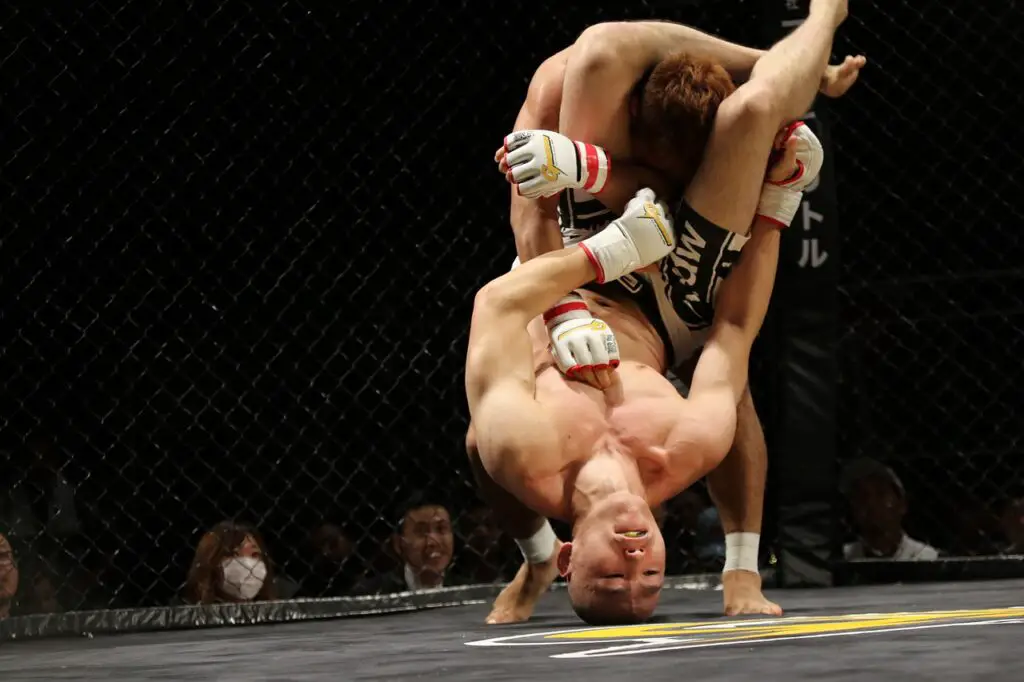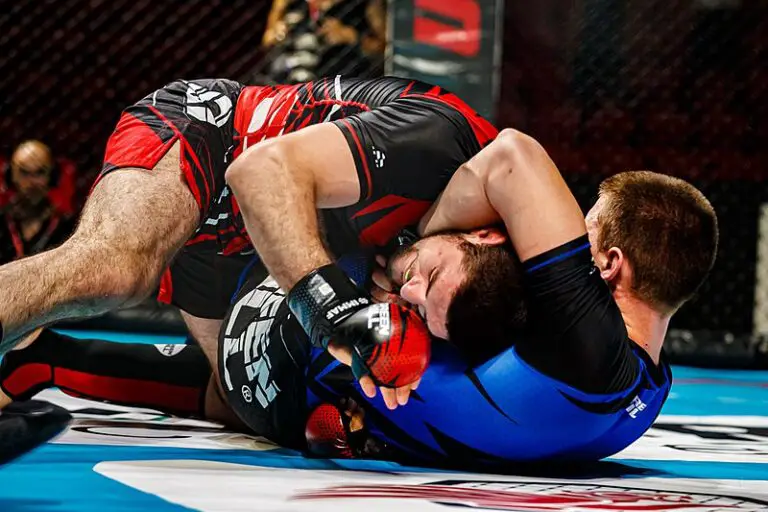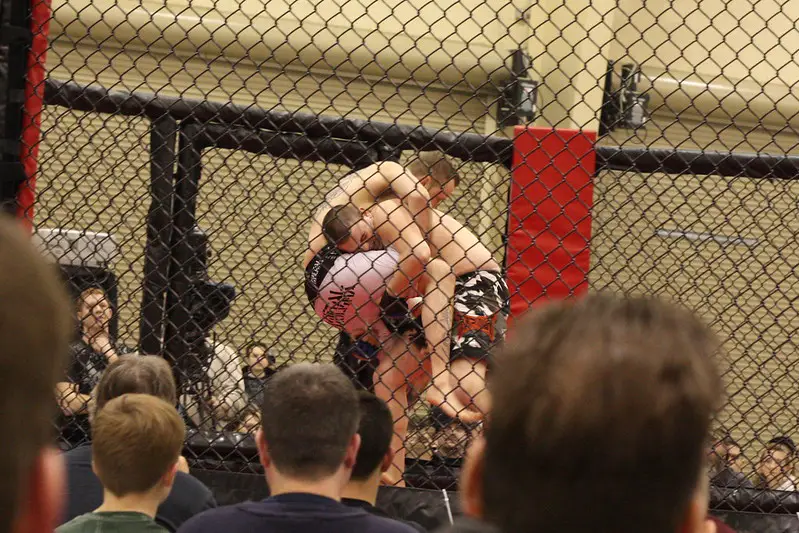Brazilian Jiu-Jitsu (BJJ) is widely regarded as one of the best self-defense combat systems. Yet, many people wonder is BJJ effective in MMA as well and how.
BJJ plays a big role in MMA because it is the most advanced ground fighting system. On average, MMA fighters spend 1 minute and 20s on the ground per round and submissions contribute to around 40% of all finishes.
Thus, BJJ skills remain essential in cage fighting and will be for many years to come.
Let’s further explore the effectiveness of BJJ in MMA, how its role changed over the years, and the reasons why it is so important.
Is BJJ Good For MMA?
BJJ plays a crucial role in the world of MMA where fighters spend, on average, almost a minute and a half on the ground in each round. Thus, having the skills to control the opponent or finish them with chokes and joint locks is important.
Each fighter must know how to navigate on the ground, maneuver into positions, escape, control, and of course, set up or defend against submissions. If they don’t the lack of ground game will catch up on them at some point in their careers.

Next, BJJ is effective for MMA as it matches well against other styles. For instance, wrestlers can execute takedowns but often get caught in a submission. Strikers, on the other side, would have a hard time defending as BJJ moves are complex and require years of practice.
Royce Gracie and his dominance in the early days of the UFC is a great example of how important jiu-jitsu is in cage fighting. During the early days without the rules, he went on to beat all the best strikers and wrestlers using jiu-jitsu only. The majority of his opponents were twice as big but this didn’t stop him from winning 3 UFC tournaments in a row.
Since then, BJJ has become an integral part of every MMA fighter’s arsenal. Fighters can’t expect to succeed without BJJ skills. Not even on the regional scene. That’s how BJJ training is important.
Why BJJ is So Effective in MMA?
BJJ is the most advanced system in terms of submissions, positioning, and escapes. There are not many alternatives fighters can train in, making BJJ the best option for developing submission grappling skills.
Let’s take a deeper look into why jiu-jitsu works so well in MMA.
Longer learning curve
One of the key advantages is the complexity. Jiu-Jitsu takes, on average, between 10–15 years to reach a black belt level, much longer than in other martial arts.
MMA is a sport full of strikers and wrestlers who upon joining the sport, must spend many years to develop proper jiu-jitsu skills. On the other side, skilled BJJ fighters would need much less to learn how to strike and counter skilled wrestlers.
So basically, fighters who come from BJJ into MMA enjoy a big advantage right from the start.
Effective Finishing Techniques
One of the main reasons why BJJ is effective in MMA is its emphasis on ground fighting skills. It equips a fighter with the skills needed to finish with joint locks or chokes.
These moves put the opponent into a position where they would either tap out or risk a serious injury. Joint locks can easily dislocate or break the bone, while chokes cut the blood supply to the brain and you go to sleep.
Fighting your way out of it also doesn’t work as you must know the exact defensive procedure to escape.
Control and positional dominance
BJJ teaches fighters how to take their opponents down to the ground and establish dominant positions. This includes mount, back control, or guard.
Once in these positions, BJJ practitioners have a wide array of techniques to maintain control. Also, it’s hard for the opponent to easily reverse or escape. They can use superior control to dictate the pace and place of the match and attack with submissions or strikes.
Gi or No Gi BJJ For MMA?
Training without the GI is more in line with MMA rules where fighters compete without wearing a uniform. Thus, no-gi resembles an actual fight where there are no clothing grips available.
The difference between the two styles is obvious. Gi style involves long pants and a jacket made out of thick cotton. No-gi, as its name suggests, doesn’t involve any uniforms and students usually wear shorts and rash guards.
While gi is typically more strategic and methodical, no-gi focuses more on speed, agility, and transitional movements which can be beneficial in cage fights.
Yet, training with the uniform also has certain advantages. This style promotes a slower and more technical approach to grappling and is much better when it comes to defense and understanding leverage and control.
However, in MMA competitions where fighters wear gloves or when opponents are slippery due to sweat or blood, No Gi BJJ is more effective.
Some fighters may choose to incorporate both styles into their training regimen. They do this to develop all-around skills and improve their submission skills for MMA.
BJJ Limitations in MMA
The key limitation is the lack of striking techniques, a one-dimensional and predictable approach, and range difficulties. Let’s take a deeper look into all the major disadvantages of BJJ in MMA.
Predictability in Approach
BJJ techniques can be very effective, but they can also be predictable. Opponents can study the fighter’s approach and anticipate their moves, making it easier to defend against them. This is notably true when the fighter relies too heavily on grappling and neglects other skills like striking and wrestling.
For example, if a fighter is known for attempting a specific submission, their opponent can prepare to defend against it.
Limited Striking Arsenal
Another technical constraint of BJJ in MMA is the limited striking arsenal of BJJ practitioners. BJJ practitioners often lack the striking power and technique necessary to compete with elite strikers in MMA. This can result in BJJ practitioners being outmatched on their feet, making it difficult to take the fight to the ground where they are most comfortable.
Range and Reach Challenges
Another limitation of BJJ in MMA is the range and reach challenges. BJJ techniques are mostly applied at close range or on the ground, whereas in MMA, fighters often engage in striking from a distance.
A BJJ practitioner may find it challenging to close the distance and take the fight to the ground, especially against a skilled striker with a longer reach.
What Are The Most Common BJJ Submissions in MMA?
The most commonly used submissions in MMA are a guillotine choke, armbar, rear-naked choke, triangle choke, and arm triangle choke. Here is a detailed look:
| Submission | Description | Notable UFC Practitioners |
|---|---|---|
| Rear-Naked Choke | Applying pressure to the opponent’s neck with the forearm, often from the back position. | Charles Oliveira, Khabib Nurmagomedov |
| Guillotine Choke | Trapping the opponent’s head and neck under the arm, creating a choking effect. | Brian Ortega, Nate Diaz |
| Armbar | Extending the opponent’s arm to hyperextend the elbow joint. | Ronda Rousey, Demian Maia |
| Triangle Choke | Using the legs to form a triangle around the opponent’s neck and arm, cutting off blood flow. | Tony Ferguson, Nate Diaz |
| Kimura | Applying a shoulder lock by controlling the opponent’s arm at the wrist and elbow. | Frank Mir, Georges St-Pierre |
Who Are the Best BJJ Fighters in UFC?
Charles Oliveira is considered one of the best Brazilian Jiu-Jitsu (BJJ) fighters in UFC history, holding the record for the most submission victories in the promotion. Some of the others are:
- Brian Ortega is known for his outstanding BJJ skills, earning a black belt under Rener Gracie.
- Demian Maia is a BJJ legend in MMA, holding a third-degree black belt in Brazilian Jiu-Jitsu. Throughout his UFC career, Maia displayed elite grappling, securing numerous submission victories and challenging for the welterweight title
- Ronaldo “Jacare” Souza, a highly decorated BJJ black belt, transitioned successfully to MMA. While competing in the UFC, Souza showcased his grappling skills, earning submission wins and establishing himself as one of the top middleweights in the organization.
- Fabricio Werdum, a BJJ black belt and former UFC Heavyweight Champion, is renowned for his grappling prowess.
Is BJJ Better Than Wrestling For MMA?
Both styles are equally important. While wrestling emphasizes top control and explosive takedowns, BJJ focuses more on positioning and finishing the opponent using submissions. So these two styles complement one another like no other two styles.
In order to succeed, all MMA fighters must train in both disciplines. On one side, they need wrestling skills to either keep the fight on the feet or take their opponent down. To prevent them from standing back up, they must have strong top control and you can’t do it without proper wrestling training.
How To Defend a Takedown in MMA (5 Best Methods)
On the other, you need BJJ to know how to maneuver on the ground, and escape or set up chokes and joint locks to finish the match. One does not go without the other so that’s why many successful MMA fighters incorporate elements of both disciplines into their training.
Is BJJ The Best Grappling Martial Art for MMA?
Yes, BJJ is widely regarded as the best martial art when it comes to submission grappling. Out of all other grappling arts, not a single one is as advanced in terms of ground fighting, which is why all MMA fighters train in MMA.
Overall, they do not have many other options. Judo, for instance, is very similar to BJJ. However, the system focuses primarily on throws. Though it includes chokes and joint locks, these are not as important as throws. Thus, the system is not as advanced as jiu-jitsu.
Wrestling is also the best for takedowns and strong top control. However, popular wrestling styles like freestyle are also quite limited. They don’t include submissions, and fighting off your back.
All of this makes BJJ the most important grappling martial art for MMA.


